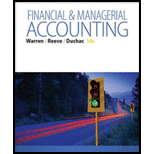
Financial & Managerial Accounting
13th Edition
ISBN: 9781285866307
Author: Carl Warren, James M. Reeve, Jonathan Duchac
Publisher: Cengage Learning
expand_more
expand_more
format_list_bulleted
Concept explainers
Question
Chapter 15, Problem 15.24EX
To determine
Extraordinary Items: There are times when a company faces unusual and infrequent gains and losses. These are accounted and reported as extraordinary items in the financial statement.
Examples:
- Losses incurred due to natural calamities.
- Company’s property taken by a foreign government authority
- Items which do not recur in the foreseeable future
To classify: whether items are normally recurring (NR) or extraordinary (E)
Expert Solution & Answer
Want to see the full answer?
Check out a sample textbook solution
Students have asked these similar questions
Provide answer me accounting
Give me solution
Over the units in a batch
Chapter 15 Solutions
Financial & Managerial Accounting
Ch. 15 - Prob. 1DQCh. 15 - What is the advantage of using comparative...Ch. 15 - A companys current year net income (after income...Ch. 15 - Prob. 4DQCh. 15 - Prob. 5DQCh. 15 - Prob. 6DQCh. 15 - Prob. 7DQCh. 15 - Prob. 8DQCh. 15 - Prob. 9DQCh. 15 - Prob. 10DQ
Ch. 15 - Prob. 15.1APECh. 15 - Prob. 15.1BPECh. 15 - Prob. 15.2APECh. 15 - Vertical analysis Income statement information for...Ch. 15 - Prob. 15.3APECh. 15 - Prob. 15.3BPECh. 15 - Accounts receivable analysis A company reports the...Ch. 15 - Accounts receivable analysis A company reports the...Ch. 15 - Prob. 15.5APECh. 15 - Inventory analysis A company reports the...Ch. 15 - Prob. 15.6APECh. 15 - Long-term solvency analysis The following...Ch. 15 - Prob. 15.7APECh. 15 - Times interest earned A company reports the...Ch. 15 - Prob. 15.8APECh. 15 - Prob. 15.8BPECh. 15 - Prob. 15.9APECh. 15 - Prob. 15.9BPECh. 15 - Prob. 15.10APECh. 15 - Common stockholders' profitability analysis A...Ch. 15 - Prob. 15.11APECh. 15 - Earnings per share and price-earnings ratio A...Ch. 15 - Prob. 15.1EXCh. 15 - Vertical analysis of income statement The...Ch. 15 - Common-sized income statement Revenue and expense...Ch. 15 - Vertical analysis of balance sheet Balance sheet...Ch. 15 - Prob. 15.5EXCh. 15 - Current position analysis The following data were...Ch. 15 - Prob. 15.7EXCh. 15 - Prob. 15.8EXCh. 15 - Prob. 15.9EXCh. 15 - Prob. 15.10EXCh. 15 - Inventory analysis The following data were...Ch. 15 - Inventory analysis Dell Inc. and Hewlett-Packard...Ch. 15 - Prob. 15.13EXCh. 15 - Prob. 15.14EXCh. 15 - Prob. 15.15EXCh. 15 - Prob. 15.16EXCh. 15 - Profitability ratios The following selected data...Ch. 15 - Profitability ratios Ralph Lauren Corporation...Ch. 15 - Six measures of solvency or profitability The...Ch. 15 - Five measures of solvency or profitability The...Ch. 15 - Prob. 15.21EXCh. 15 - Prob. 15.22EXCh. 15 - Prob. 15.23EXCh. 15 - Prob. 15.24EXCh. 15 - Prob. 15.25EXCh. 15 - Prob. 15.26EXCh. 15 - Horizontal analysis of income statement For 2016,...Ch. 15 - Prob. 15.2APRCh. 15 - Prob. 15.3APRCh. 15 - Nineteen measures of solvency and profitability...Ch. 15 - Solvency and profitability trend analysis Addai...Ch. 15 - Prob. 15.1BPRCh. 15 - Prob. 15.2BPRCh. 15 - Effect of transactions on current position...Ch. 15 - Nineteen measures of solvency and profitability...Ch. 15 - Prob. 15.5BPRCh. 15 - Financial Statement Analysis The financial...Ch. 15 - Prob. 15.1CPCh. 15 - Prob. 15.2CPCh. 15 - Prob. 15.3CPCh. 15 - Prob. 15.4CPCh. 15 - Prob. 15.5CP
Knowledge Booster
Learn more about
Need a deep-dive on the concept behind this application? Look no further. Learn more about this topic, accounting and related others by exploring similar questions and additional content below.Similar questions
- Pell Company acquires 80% of Demers Company for $500,000 on January 1, 2022. Demers reported common stock of $300,000 and retained earnings of $210,000 on that date. Equipment was undervalued by $30,000 and buildings were undervalued by $40,000, each having a 10-year remaining life. Any excess consideration transferred over fair value was attributed to goodwill with an indefinite life. Based on an annual review, goodwill has not been impaired. Demers earns income and pays dividends as follows: 2022 2023 2024 Net income $ 100,000 $ 120,000 $ 130,000 Dividends 40,000 50,000 60,000 Assume the partial equity method is applied. Compute the noncontrolling interest in Demers at December 31, 2024. Multiple Choice $146,800 $160,800 $107,800 $80,000 $140,000arrow_forwardProvide General Accounting Questionarrow_forwardProvide answer pleasearrow_forward
arrow_back_ios
SEE MORE QUESTIONS
arrow_forward_ios
Recommended textbooks for you
- Principles of Accounting Volume 1AccountingISBN:9781947172685Author:OpenStaxPublisher:OpenStax College




Principles of Accounting Volume 1
Accounting
ISBN:9781947172685
Author:OpenStax
Publisher:OpenStax College